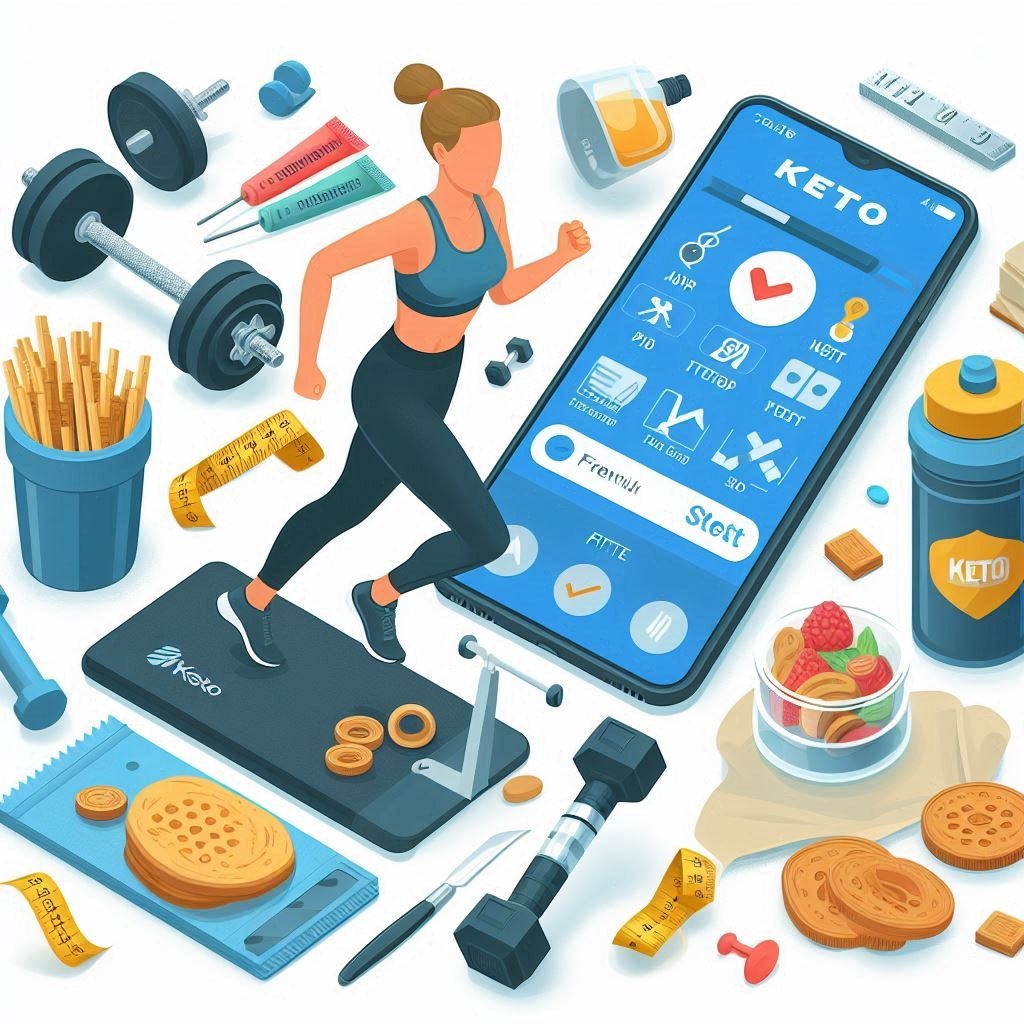Take Control of your Keto Diet Today...
Looking to start a keto diet but feeling overwhelmed? This essential guide has got you covered!
From essential steps and practical tips to potential challenges, you’ll learn everything you need to know to kickstart your keto journey with confidence.
Understanding the Basics of Keto
Research indicates that individuals adhering to the low-carb keto diet are more inclined to experience weight loss within the initial 3 to 6 months compared to those following a more balanced diet.
What is the keto diet?
The keto diet is a unique variation of the low carb diet, with specific features.
The ideal carb intake varies based on insulin tolerance and activity level, but typically, the following are the recommended daily carb limits:
Some individuals prefer to meticulously count carbs, while others opt to concentrate on consuming low carb or keto-friendly foods.
Keto diet – Under 20g net carbs per day (occasionally up to 25g or 30g)
Low carb diet – Under 50g net carbs per day
Moderate low carb diet – Under 100g net carbs per day
This Ultimate Beginners Guide Explains the Keto Diet in full detail…
The Scientific Perspective:
From a scientific viewpoint (1), the ketogenic diet is a highfat, lowcarbohydrate eating plan that has been shown to have various health benefits.
Research has demonstrated that the ketogenic diet can help with weight loss, improve insulin sensitivity, and even reduce the frequency of seizures in some individuals with epilepsy.
Studies have also suggested that the ketogenic diet may have potential therapeutic applications in conditions such as Alzheimer’s disease, cancer, and diabetes.
The Critic’s Perspective:
Critics of the ketogenic diet often raise concerns about its potential longterm effects on heart health due to the high intake of saturated fats.
They also point out the challenges of adhering to such a restrictive eating plan, which may lead to nutrient deficiencies and social limitations.
Some experts caution that the ketogenic diet may not be suitable for everyone, particularly those with certain medical conditions or athletes requiring highintensity exercise performance.
Additionally, there are concerns about the lack of longterm research on the safety and efficacy of the ketogenic diet.
The Personal Experience Perspective:
Many individuals have reported positive experiences with the ketogenic diet, citing benefits such as increased energy levels, better mental clarity, and improved weight management.
For example, some people have shared their personal success stories of losing significant amounts of weight and maintaining their results over time by following a ketogenic eating plan.
Others have described how the ketogenic diet has helped them better manage conditions like polycystic ovary syndrome (PCOS)(2) or migraines.
How does the keto diet work?
Rapid weight loss: The keto diet helps the body burn fat for fuel, leading to quick and noticeable weight loss.
Increased energy levels: By stabilizing blood sugar levels and reducing reliance on carbohydrates, the keto diet can provide a steady source of energy throughout the day.
Better blood sugar control: For those with insulin resistance or diabetes, the keto diet can help regulate blood sugar levels and reduce the need for medication.
Reduced inflammation: The keto diet has been shown to reduce inflammation in the body, which can lead to decreased pain and improved overall health.
Improved mental clarity: Many people report improved focus and mental clarity while following the keto diet, possibly due to the reduction in blood sugar spikes and crashes.
Read this article for a much deeper dive into ‘How the Keto Diet works’…
Essential Steps to Kickstart Your Keto Journey
Educate yourself about the keto diet by researching reputable sources such as books, websites, or consulting with a healthcare professional.
Incorporate regular physical activity into your routine to support your overall health and enhance the benefits of the keto diet.

Clean out your pantry
Remove highcarb foods from your pantry and refrigerator to eliminate temptation and make room for ketofriendly options.
Plan your meals
Plan your meals by focusing on lowcarb, highfat foods such as meat, fish, eggs, cheese, and vegetables.
Calculate your macros
Track your macronutrient intake using a food diary or mobile app to ensure you are staying within the recommended keto ratios of
- 70-75% fat.
- 20-25% protein.
- 5-10% carbs.
You can use our Keto Macro Calculator and guide to see how your macros look here…
Practical Tips for Success on Keto

Stay hydrated
Stay hydrated and replenish electrolytes by drinking plenty of water and consuming foods rich in potassium, magnesium, and sodium.
Monitor your carb intake
Monitor your progress and adjust your meal plan and activity levels as needed to achieve your desired results while maintaining a healthy lifestyle.
Our article ‘Tips For Keto Success’ provides an in-depth list of keto tips…
Potential Challenges and How to Overcome Them
Keto flu
Medical Perspective:
From a medical standpoint, the keto flu is a collection of symptoms that some people experience when they start the ketogenic diet.
These symptoms can include fatigue, headache, dizziness, nausea, and irritability, and are often attributed to the body adjusting to the switch from using carbohydrates to using fat for energy.
Some medical professionals recommend increasing salt intake and staying wellhydrated to help alleviate these symptoms.
For example, a study published in the Journal of Clinical Lipidology(3) found that participants experienced symptoms resembling the flu during the initial phase of the ketogenic diet, suggesting that these symptoms are a real phenomenon.
Nutritional Perspective:
From a nutritional perspective, the keto flu can be seen as the body’s reaction to a sudden reduction in carbohydrates and the adjustment to using fat as the primary source of fuel.
Some nutritionists believe that the symptoms of the keto flu can be minimized by gradually reducing carbohydrate intake and ensuring adequate intake of electrolytes and micronutrients.
For instance, a review published in the journal Nutrients(4) highlights the importance of maintaining proper electrolyte balance and nutrient intake during the transition to a ketogenic diet to prevent or reduce the severity of the keto flu.
Personal Experience Perspective:
From the perspective of individuals who have tried the ketogenic diet, the keto flu is a real and challenging experience that can vary widely from person to person.
Some people may not experience any symptoms, while others may feel extremely fatigued and unwell. Many individuals share their personal strategies for managing the keto flu, such as increasing their intake of sodium and potassiumrich foods, staying wellhydrated, and getting plenty of rest.
Personal anecdotes and testimonials from those who have experienced the keto flu can provide valuable insights into the individualized nature of this phenomenon.
Social situations and dining out
- Look for restaurants that offer a variety of protein options such as steak, chicken, or seafood.
- Choose restaurants that have a selection of lowcarb vegetable sides like broccoli, spinach, or asparagus.
- Avoid restaurants that heavily rely on bread, pasta, or rice as the main components of their dishes.
- Consider checking the menu online beforehand to ensure there are ketofriendly options available.
- Look for restaurants that are willing to accommodate special dietary requests, such as substituting starchy sides with extra vegetables or a salad.
Managing Setbacks

Acknowledge the setback:
When facing a setback on the keto diet, such as a plateau or indulging in nonketo foods, acknowledge the setback and accept that it happened.
Reflect on the cause:
Take a moment to reflect on what may have caused the setback. It could be stress, lack of planning, or simply giving in to cravings.
Revisit your goals:
Remind yourself of the reasons why you started the keto diet in the first place. Revisiting your goals can help reignite your motivation.
Seek support:
Reach out to a friend, family member, or online keto community for support and encouragement. Sharing your struggles with others can help you stay motivated.
Staying Motivated and Tracking Progress
Set realistic goals
Plan for success:
Create a plan to overcome the setback. This could involve meal prepping, finding new ketofriendly recipes, or incorporating more physical activity into your routine.
Stay consistent:
Consistency is key on the keto diet. Stick to your meal plan, track your macros, and stay committed to the lifestyle changes that come with the keto diet.
Celebrating little victories
Stay positive:
Focus on the progress you have made so far and stay positive about the journey ahead. Celebrate small victories and stay optimistic about reaching your goals.
Use apps and tools for tracking progress

By following these steps, you can effectively manage setbacks and maintain motivation on the keto diet, ultimately leading to success in reaching your health and wellness goals.
Your Keto Meal Plan Should Be As Unique As YOU.
As a beginner, finding a diet plan that takes the guesswork out might be the difference between success and failure.
FREE for 7 days. Start Your 7-Day FREE Trial

Incorporating Exercise into Your Keto Lifestyle
Benefits of exercise on keto
From a scientific standpoint, exercise on a keto diet can enhance the body’s ability to burn fat for fuel. When the body is in a state of ketosis, it becomes more efficient at using fat as an energy source. Exercise can further promote this fatburning process, leading to potential weight loss and improved body composition.
For example, a study published in the Journal of Physiology found that aerobic exercise in combination with a ketogenic diet can lead to an increased capacity for fat oxidation, which may be beneficial for athletes and individuals looking to improve their metabolic health.
Some individuals following a keto diet may experience improved workout performance and endurance.
While the body may take some time to adapt to using fat as its primary fuel source, once adapted, some people report sustained energy levels during exercise and reduced reliance on carbohydrates for energy.
This can be particularly beneficial for endurance athletes, such as longdistance runners or cyclists.
For instance, a case study published in the Journal of the International Society of Sports Nutrition(5) documented an endurance athlete’s successful performance improvements after transitioning to a ketogenic diet, suggesting that the diet may have positive effects on exercise capacity.
On the other hand,
some people may find that highintensity exercise, such as sprinting or heavy weightlifting, is more challenging on a keto diet due to the reduced availability of glycogen, which is the body’s primary fuel source during intense physical activity.
Without sufficient glycogen stores, individuals may experience decreased power and performance during highintensity workouts.
This perspective is supported by a study published in the Journal of Sports Science & Medicine(6), which found that while a ketogenic diet may have benefits for endurance exercise, it may impair high-intensity exercise performance in some individuals.
Precautions and considerations for exercising on keto

Stay hydrated:
It’s important to drink plenty of water, especially when following a ketogenic diet, as the body excretes more water and electrolytes on keto.
Monitor energy levels:
Some people may experience a decrease in energy levels when first starting a ketogenic diet, so it’s important to listen to your body and adjust exercise intensity as needed.
Consider targeted carbohydrates:
For highintensity workouts, some individuals may benefit from consuming a small amount of carbohydrates before exercise to provide quick energy.
Pay attention to electrolytes:
Since the body excretes more electrolytes on keto, it’s important to ensure adequate intake of sodium, potassium, and magnesium to prevent muscle cramps and fatigue.
Allow for adaptation:
It may take some time for the body to fully adapt to exercising on a ketogenic diet, so be patient and give your body time to adjust to using fat as its primary fuel source.
Conclusion and Next Steps

Educate yourself about the keto diet by researching online or reading books about the principles and guidelines of the diet.
Clean out your pantry and refrigerator, removing any highcarb and sugary foods such as bread, pasta, rice, potatoes, and sweets.
Make a list of ketofriendly foods such as meat, fish, eggs, cheese, lowcarb vegetables, nuts, and healthy fats like avocados and olive oil.
Stock up on ketofriendly groceries and ingredients, ensuring you have plenty of options for meals and snacks.
Plan your meals for the first week, focusing on recipes that are low in carbs and high in healthy fats and protein.
Start your keto journey by preparing and enjoying your first ketofriendly meal, and be sure to stay hydrated by drinking plenty of water.
Monitor your body’s response to the diet, paying attention to any changes in energy levels, hunger, and overall wellbeing.
Consider consulting with a healthcare professional or nutritionist to ensure that you are following the keto diet safely and effectively.
Frequently Asked Questions
1. Understanding the Basics of the Keto Diet
2. Planning and Preparing KetoFriendly Meals
3. Incorporating Exercise and Physical Activity
4. Monitoring Progress and Making Adjustments
Fasting for 72 hours, or three consecutive days without food, can induce a state of ketosis in the body.
1. Know What Foods You Can Eat and Which to Avoid.
2. Be Prepared to Eat Lots of Fat.
3. Know How Much Protein to Eat (it’s Probably Less Than You Think!)
4. Get Familiar with Reading Nutrition Labels.
5. Stay Hydrated.
6. Know That You May Experience the “Keto Flu”
7. Meal Plan Like a Pro
Citations & References
- NIH.gov – The Potential Health Benefits of the Ketogenic Diet
- Medical News Today – Could the keto diet be a fertility treatment for women with PCOS?
- Journal of Clinical Lipidology – Low-Carbohydrate Diets
- MDPI Journal – Nutrients
- Journal of the International Society of Sports Nutrition – Effects of 30 days of ketogenic diet on body composition, muscle strength, muscle area, metabolism, and performance in semi-professional soccer players
- Journal of Sports Science & Medicine – Acute Effects of High-intensity Resistance Exercise on Cognitive Function









